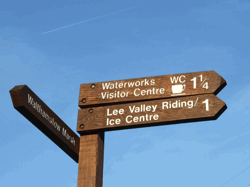 |
|
| What is open space? |
| Lea Marshes is on Metropolitan Open Land, often called the green belt for urban areas. But what is the legal definition of open space and can it possibly include an area that has been fenced off and used for business purposes (like the riding centre,
currently being turned, in April 2013, into what amounts to a stabling area for the rich and privileged with fences there to stop the general public from getting in).
The Town and Country Planning Act 1990 section 336 defines Open Space as including "any land . . . used for the purposes of public recreation." Land that is enclosed but is being used for public recreation can be defined as "open space," but paddocking where horses are stabled, and where there is no point of entry for the general public, can not be termed "public open space." The Open Spaces Act 1906 section 20 defines Open Space as "any land, whether inclosed or not ... of which not more that one-twentieth part is covered with buildings, and the whole or the remainder of which is laid out as a garden or is used for purposes of recreation or lies waste and unoccupied." Clearly, the riding centre would now struggle to meet this definition. If and when the viewing gallery (given planning permission under 2009/0244 ) is built the situation will be even worse. In 1904 Lammas Grazing Rights on Leyton Marshes (commuted by the Leyton Corporation Act) gave the right of free access in perpetuity to the public from January 1905. This was carried out with the agreement of the parishioners, who had enjoyed Lammas grazing rights on the Marshes since time immemorial (see 1892 riot ). When the Lee Valley Regional Park was set up in 1967, it obtained some of the lands within its boundary by means of Compulsory Purchase Orders. This included about 72 acres of former Lammas Land on Leyton Marshes and just under 100 acres of former Lammas Lands on Walthamstow Marshes (the CPO was made in 1969 and confirmed in 1971). The Park Authority claim that because the land was compulsorily purchased all former covenants relating to the commutation of Lammas and other Commonable Rights were negated. LVRPA also claims that the Town & Country Planning Act 1971 gives them the right to do anything they want on land they own (sometimes irrespective of the provisions let alone the spirit of the 1966 Lee Valley Regional Park Act). The Riding Centre was originally based only on Leyton Marshes, but has since then made encroachments beyond its original area (temporary wartime housing) onto a field on Walthamstow Marshes north of the Parish Boundary. This field was fenced off in about 1990 and was massively refenced creating a network of small paddocks, in 2013, affording no point of access to the public. LVRPA is essentially privatising land that has always belonged to the people of Walthamstow and Leyton and is increasingly fencing us out with barbed wire and electrified fencing. This is not the action of a Regional Park, it is the action of a greedy landowner trying to run a business (private horse stabling) on public land. |
|